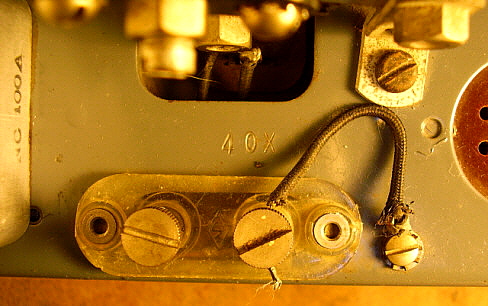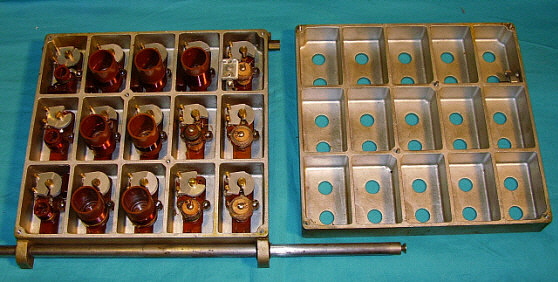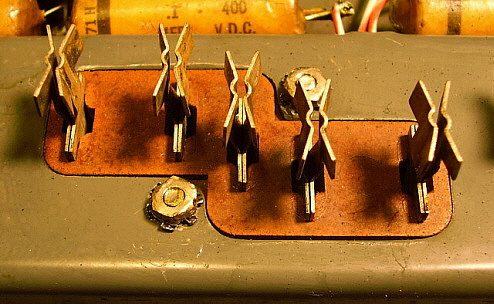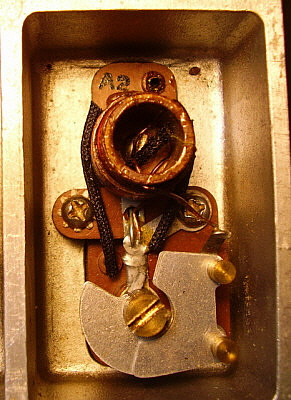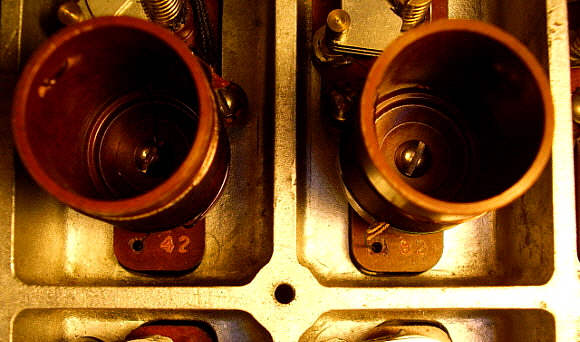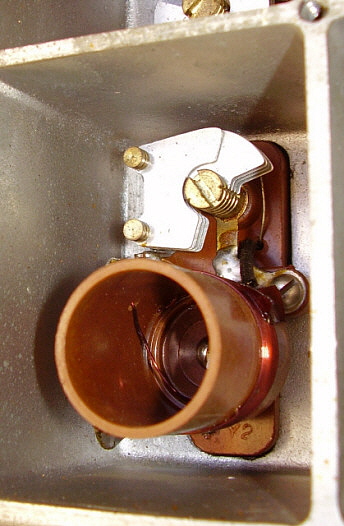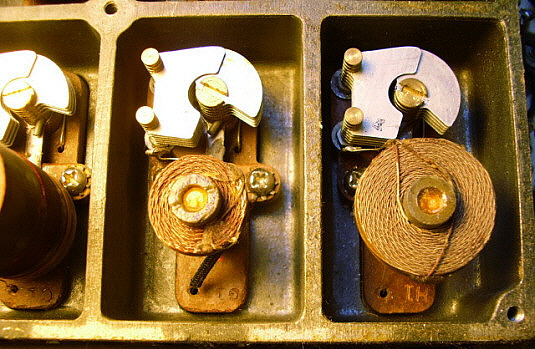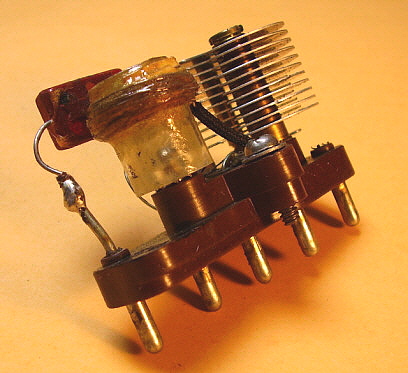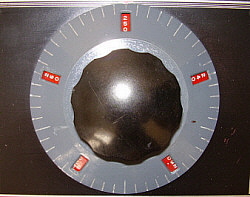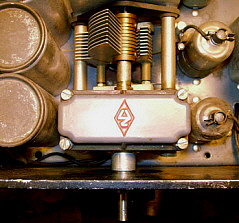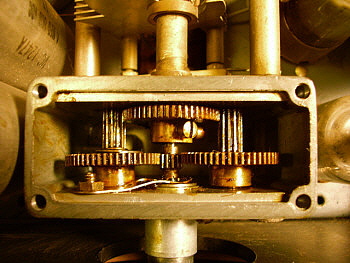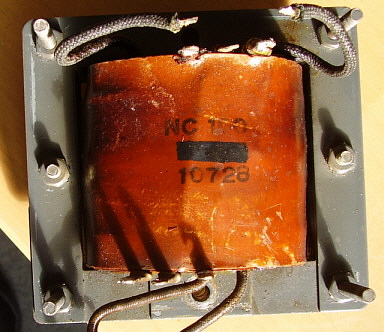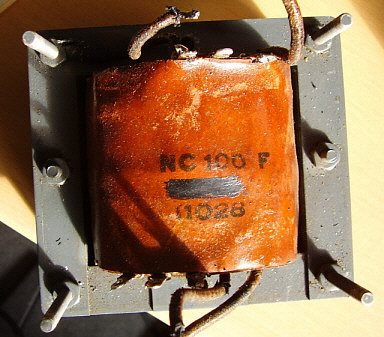| 1936
NC-100 and NC-100X introduced in August 1936
The Art Deco Panel - Aluminum sheet metal overlay for front panel is silk screened in
black and red along with silver - used on both NC-100 and NC-100X,
commonly referred to as the "Art Deco Panel." This panel was only used
from the initial run-D up through run-G on the NC-100 and NC-100X. A black wrinkle finish
overlay replaced the Art Deco panel and the eye tube was integrated in
the same manner as the NC-101X. The PW-D likely would have also been
changed to the black with black number dial, the same as the NC-101X. This change
probably happened during or just after run-G. Certainly, by run-J, the S-meter
replaced the eye-tube and then, at the very latest, the Art Deco panel was
gone for good. It was certainly not used after the replacement of the
eye-tube with the S-meter (run-J or mid-1937.) The Art Deco panel was
replaced for a couple of reasons. First, it was delicate and scratched
very easily. Excessive rubbing would easily wear through all of the
silk-screen artwork and would also wear the matte silver finish. The second
reason
was as an expense reduction by the consolidation of parts. The Art Deco panel was unique to
the NC-100 and NC-100X and certainly the process to produce the panel
(or have it produced)
was more expensive than a black wrinkle paint job. It was much easier
and less expensive for National to start using the NC-101X black wrinkle
overlay with these types of panels which were then usable on three types of receivers.
The PW-D - The initial PW-D micrometer dial used on early receivers was
bluish-gray on the Index Dial and red with white numbers on the Number
Dial, used on the NC-100 and possibly the very early versions of the NC-100X. Slight variations in PW-D
paint color might be due to color variations in different paint mixes or
due to different aging characteristics on specific PW-D dials. However,
many PW-D dials were replaced over the years by owners and careless
restorers so originality becomes uncertain. Generally, very early NC-100
receivers will have the bluish-gray Index Dial and red with white
numerals Number dial. The NC-100X will usually have a light-gray
Index dial with a black number dial with white numerals. There may be exceptions to this
but, from examples seen, this PW-D difference between the NC-100 and the
NC-100X seems to be consistent. Photo of 638-G (eBay) had deco panel and
light gray PW-D with black number dial with white numerals - looked
original. Also, NC-100X sn:48E, an original example, has a gray Index dial with a black
Number dial. I don't have any data collected on whether the red number
dial was used in the PW-D for the NC-100 past the first production run.
Please report any NC-100 receivers in the E, F or G runs that have been
found with original red number dial PW-D.
Chassis is painted gray on both NC-100 and NC-100X
Power transformer top cover has four large ventilation holes
6E5 cathode ray tuning eye tube is used
Rack mount versions will not have aluminum overlay, panel is 3/16"
aluminum with engraved markings, black wrinkle finish, eye tube used.
Some versions may have single-ended audio output. Some rack mounted
versions will use National-supplied rack mounting brackets that mount to
the sides of the standard NC-100 table cabinet.
The first NC-100 and NC-100X receivers were built in production run
"D"
The NC-100 was the first National Co. receiver to utilize an
electrodynamic loudspeaker that had its field coil powered by the
receiver's power supply. Although there were some SW-5 versions that had
push-pull audio output, these receivers had to utilize a "self-powered"
electrodynamic loudspeaker. These speakers had an onboard power supply
just for the field coil and they were popular in the late-twenties and
early-thirties.
NC-101X is introduced with ham band only coverage, black PW-D on most
of production, eye tube on early versions (NC-101X introduced during "E"
production run, probably Oct-Nov 1936)
1937
Contracts for Airport "Communication Receiver" from Dept. of
Commerce, Bureau of Air Commerce Air Navigation Division. DOC-BAC
receivers are the RCD and RCE
S-meter replaced eye-tube in NC-101X - changeover to S-meter seems to
have occurred between runs J to L (runs six, seven or eight, or around
mid-1937.) Some earlier NC-101X receivers seem to have been modified to
replace the eye tube with an S-meter. Some of these upgrades were
obviously rework performed at National and exhibit professional-level
installations. Others appear to be "hamster" modifications. For example,
NC-101X sn 247-J is a sixth production run receiver but has the later
Marion Electric yellow scale S-meter installed instead of an eye-tube or
the earlier white face Marion Electric meter. Since some hams sent their
receivers to National for repairs or upgrades, it's possible that early
production run receivers that have yellow scale S-meters may have been
replacements that were installed by National during a repair. It's also
possible that late-style replacement S-meters were obtained from
National were installed by receiver owners. In general, on original
receivers that haven't been reworked, expect to see the white face
S-meters from around run J up to around run N. The yellow face S-meter
should be installed on receivers from around run P up to around run Y
(probably early-1938 up to 1940.) This change also affected the NC-100
and NC-100X and (at the very latest) eliminated the "Art Deco" overlay on
those receivers.
Power transformer top cover vent holes eliminated
Installation of the S-meter switch eliminated the green pilot lamp so
all S-meters were illuminated to provide a "power on" indicator. All
stock S-meters were manufactured by Marion Electric.
NC-80X and NC-81X AC-DC receivers introduced. Optional power
transformer available to convert to AC-only operation. Also a
battery-operated version was available.
1938
NC-100A and NC-100XA introduced in June 1938. New direct-read dial,
articulated pointer, illuminated S-meter, cabinet height increased to
10.5", weighted tuning knob on early versions. White face S-meter used
on earliest production. The transition to the yellow face meter probably
coincides with the NC-101X meter change around run-P.
Contracts for "Airway Communication Receivers" begin - the U.S. Civil
Aeronautics Authority, the CAA, was formed in 1938. CAA receivers begin
with the RCF-2 version. All Airport and Airway receivers use a PW-D with
a light gray color Index dial and a black Number Dial with white
numerals. This light gray color Index dial is quite different than the
bluish-gray Index dial used on the earlier NC-100 PW-D.
NC-101XA introduced. Both versions (direct read dial or PW-D
micrometer dial) are available up around mid-1940.
Some models will be found with fiber board, blade screw terminals
Antenna and Ground connections. These probably replaced the
problem-prone push button terminals found on earlier models. This piece
was the transition part that then led to the polystyrene insulated
Antenna and Ground terminals with thumb screw fasteners.
1939
Noise Limiter circuit added to NC-100A versions. 6F8G (1stAF/AVC Amp)
and 6C8G (Detector/NL) replaced the 6C5 (Detector) and 6J7 (AVC Amp)
tubes. The Noise Limiter was also incorporated into the NC-101X
receivers along with the tube changes. NL available November 1939. On
NC-101X with NL, the control is between the RF Gain and the Band Change
knob where the National NC diamond logo was engraved. The "NC" diamond
logo is relocated on these NL receivers to the upper right corner of the
front panel.
By late-1939, NC-101X receivers will use NC-100XA chassis but are
built as NC-101X receivers. That is, all holes needed for the "A"
direct-read dial are present on the NC-101X chassis although not needed
or used. Usually, one side of the chassis will have "101-X" written in
orange grease pencil to ID chassis so assemblers know not to install the
"A" dial and "A" gear box.
NC-80X and NC-81X not produced after 1939. NC-80X cut-off may be
1938. Neither receiver sold well and examples are rarely encountered
today.
1940
Tuning condenser design changed to replace large bakelite insulator
plates with smaller round insulators, thin metal dividers replaced with
thicker metal dividers that now support the rotor contact insulators,
rotor plate hub changed from brass to steel, support rods dimensions
reduced, two screw rear mounting flange. Cost reduction? HRO tuning
condenser went through similar changes.
Antenna/Ground thumb-screw terminals with Polystyrene insulator
replaces the old "push terminals" with fiber board insulator or the
fiber board, screw terminals found on some models.
NC-101X production stops before May 1940. The direct-read dial
version - NC-101XA - production may have continued until the NC-200 was
incorporated into production (Sept-Oct.)
When the two-screw rear mounting flange was used on the tuning
condenser, the serial number location had to be moved to the left side
of the antenna terminal insulator (nearer to the audio output tubes.)
NC-200 introduced (October) - features both general coverage and band
spread coils within the catacomb thus eliminating the need for separate
"ham bands only" receivers like the NC-101X or NC-101XA.
NC-200 Crystal Filter changed from variable condenser Selectivity
control to six-position switch with five selectivity positions and "off"
position. Crystal at 455kc to match new IF frequency.
LO tube changed to a 6J5 triode in NC-200 Series. Many other tube
changes in the NC-200, see tube line up in section below "Vacuum Tubes
Used in All NC-100 and NC-200 Series Receivers."
Dec. 1940 QST ad for "Silver Anniversary" NC-200. Special NC diamond
insignia on receiver and matching speaker. Also, receiver equipped with
brown knobs and brown S-meter case. All round control nomenclature
plates, the tuning knob's skirt and the Silver Anniversary NC diamonds
are finished in "gold tone." The Silver Anniversary NC-200 celebrated
QST's 25th year and wasn't associated with any National anniversary.
Silver Anniversary models start as early as C-33 and run until as late
as D-639. NC-200 receivers D-700 and D-716 are both standard NC-200
receivers indicating that the Silver Anniversary ended by D-700.
NC-200 early versions will have a flat dial cover that is glass
(similar to the NC-100A versions.) Some early NC-200 receivers had
plexiglass as the dial cover. Other early NC-200 receiver used the
vacuum-molded plastic dial cover but it was mounted using clamps located
on the inside of the front panel. Later versions of the NC-200 will have
the slightly convex vacuum-molded plastic dial cover that is mounted
with two exterior metal strips held to the panel with screws.
1941-45
RAO USN versions - RAO, RAO-1,2,6,7 & 9 built by National, RAO-3,4 &
5 built by Wells Gardner & Company. RAO-2 through 9 have double preselection. All
versions have .54mc to 30mc coverage. Early versions have 500 Z ohm
audio outputs, RAO 7 & 9 have 600 Z ohm audio output. RAO-2 thru 6 are
17.5" wide, RAO-7 & 9 are 19" wide. RAO-6, 7 & 9 don't have S-meters
installed but have an output for panadaptor use instead. First 200 RAO-6
receivers were equipped with S-meters but the remaining production had
the panadaptor set-up. RAO-7 & 9 have
unique molded skirt bar knobs. Gears used in the later gearboxes are
changed from brass gears to cast pot metal gears for wartime material
conservation. Late gearboxes have an added idler gear with mechanical
stops to limit the total main tuning shaft revolutions to slightly over
ten turns. The double pre-selection design upgrade with the add-on
chassis, coil box and sheet metal cabinet pieces certainly pre-dates
WWII and may have been available to USN as early as mid-1941. As an
example, the R-116 USCG receiver from a May 15, 1941 contract has dual
preselection incorporated identically to the RAO-2 receiver although the
receiver itself has significant differences in front panel layout,
mechanical design, frequency coverage and tubes used. Also, utilizes a
separate power source (AC power supply, batteries or other shipboard
power source.)
RBH USN version of NC-100XA with special frequency coverage of 300kc
to 1200kc and 1700kc to 17.0mc, IF changed to 1500kc, single ended
audio, 500 Z ohm output. Later versions, starting with RBH-1,
added an extra RF amplifier similar to the RAO and for similar reasons.
It's likely that the RBH series follows the same evolution that the RAO
did.
NC-100ASD Signal Corps version, ca: 1943 - replaced AM BC coverage
with 200kc to 400kc, single 6V6 audio output with 500 Z ohm output
transformer. Serial number is stamped into the chassis between the 6C8
and 6F8 tubes. Serial number is three numerical digits. Highest reported
numerical SN is 948. Two serial numbers have been reported that incorporate the
letter "A" as a prefix, e.g., A059. It's probable that the "A" indicates
"1000" and A059 would be 1059 for a numerical conversion. A578
has also been reported which implies production quantity was over 1500
receivers. As to why the
letter prefix? It may have designated a second production run for the
same contract and was National's way to keep track of the receiver
manufacture (just conjecture.) The ASD may have been a replacement for NC-100ASC (aka
AN/GRR-3) that might have been a "militarized" NC-100XA.
NC-200FG, R-115 (USCG), NC-240C and NC-240CS produced during WWII.
These receivers do not have band spread function. The CS version had
200kc to 400kc band to replace the AM BC band. The R-115 has no crystal
filter, no tone control, no S-meter and no logging scale. Covers 200kc
to 400kc and 500kc to 18mc.
NC-100A, NC-100XA and NC-200 offered in the National section of the
1945 Radio Amateur's Handbook. None of these receivers, or any other
items listed, were actually available during the war and each page of
the catalog states "Priorities are required for all products in this
catalog until otherwise released by the War Production Board." The
intention of the catalog was to show what National was probably going to
have available after the war ended.
In 1945, Schuttig & Co. modified RCL and RCK Airway receivers into
RCP Airway receivers. The RCK-N built during WWII used a 1560kc IF and
tuned 200kc to 800kc and 2.5mc to 23.5mc in five tuning ranges. 6C5
tubes, the detector and the squelch tubes, are replaced with 6J7 tubes
in the RCQ versions.
1946-49
NC-240CS sold to the civilian market in post-war 1945 as a 1946
model. In 1946, National designated the CS version as a "commercial
receiver"
NC-240D returned the band spread function and was sold from
early-1946 up to 1949. Note in SN Log that F-104 is a CS model w/o BS
and that F-478 is a D model with BS. Both receivers are from the same
production run "F" which indicates that this change was rapidly
incorporated. Early NC-240D dials are similar to NC-200 dial with all
four Band Spread scales near the center of the circular arc of the
scales. Later NC-240D dials will have the Band Spread scales alternating
with and located above the General Coverage scales on bands D, C, B and
A.
In 1948, National Electrical Machine Shops (NEMS) modified RCL and
RCK Airway receivers (or parts from these types of receivers) into RCQ
Airway receivers
In 1948, some NC-240CS receivers were produced as RCR Airway
Receivers. The RCR is the last National Airway receiver produced based
on a Moving Coil receiver design. |
